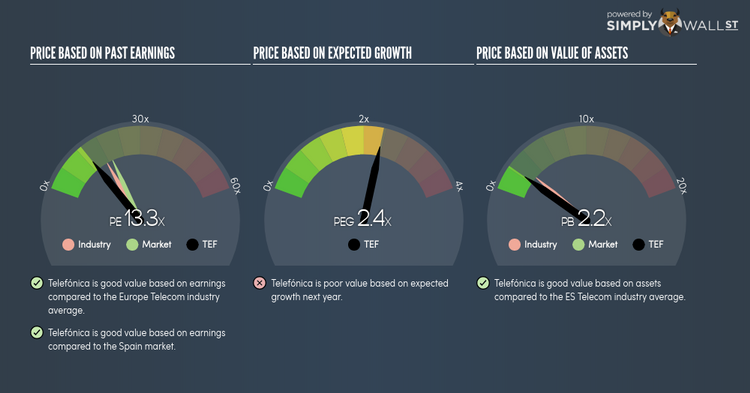Does Telefónica SA.’s (BME:TEF) PE Ratio Signal A Buying Opportunity?

Telefónica SA. (BME:TEF) trades with a trailing P/E of 13.3x, which is lower than the industry average of 16.9x. While TEF might seem like an attractive stock to buy, it is important to understand the assumptions behind the P/E ratio before you make any investment decisions. In this article, I will explain what the P/E ratio is as well as what you should look out for when using it. Check out our latest analysis for Telefónica
Breaking down the P/E ratio
P/E is a popular ratio used for relative valuation. By comparing a stock’s price per share to its earnings per share, we are able to see how much investors are paying for each dollar of the company’s earnings.
P/E Calculation for TEF
Price-Earnings Ratio = Price per share ÷ Earnings per share
TEF Price-Earnings Ratio = €7.58 ÷ €0.568 = 13.3x
On its own, the P/E ratio doesn’t tell you much; however, it becomes extremely useful when you compare it with other similar companies. We preferably want to compare the stock’s P/E ratio to the average of companies that have similar features to TEF, such as capital structure and profitability. A common peer group is companies that exist in the same industry, which is what I use. Since TEF’s P/E of 13.3x is lower than its industry peers (16.9x), it means that investors are paying less than they should for each dollar of TEF’s earnings. As such, our analysis shows that TEF represents an under-priced stock.
Assumptions to watch out for
However, before you rush out to buy TEF, it is important to note that this conclusion is based on two key assumptions. The first is that our “similar companies” are actually similar to TEF, or else the difference in P/E might be a result of other factors. For example, if you compared higher growth firms with TEF, then its P/E would naturally be lower since investors would reward its peers’ higher growth with a higher price. The second assumption that must hold true is that the stocks we are comparing TEF to are fairly valued by the market. If this is violated, TEF’s P/E may be lower than its peers as they are actually overvalued by investors.
What this means for you:
You may have already conducted fundamental analysis on the stock as a shareholder, so its current undervaluation could signal a good buying opportunity to increase your exposure to TEF. Now that you understand the ins and outs of the PE metric, you should know to bear in mind its limitations before you make an investment decision. Remember that basing your investment decision off one metric alone is certainly not sufficient. There are many things I have not taken into account in this article and the PE ratio is very one-dimensional. If you have not done so already, I highly recommend you to complete your research by taking a look at the following:
Future Outlook: What are well-informed industry analysts predicting for TEF’s future growth? Take a look at our free research report of analyst consensus for TEF’s outlook.
Past Track Record: Has TEF been consistently performing well irrespective of the ups and downs in the market? Go into more detail in the past performance analysis and take a look at the free visual representations of TEF’s historicals for more clarity.
Other High-Performing Stocks: Are there other stocks that provide better prospects with proven track records? Explore our free list of these great stocks here.
To help readers see pass the short term volatility of the financial market, we aim to bring you a long-term focused research analysis purely driven by fundamental data. Note that our analysis does not factor in the latest price sensitive company announcements.
The author is an independent contributor and at the time of publication had no position in the stocks mentioned.

 Yahoo Finance
Yahoo Finance 
